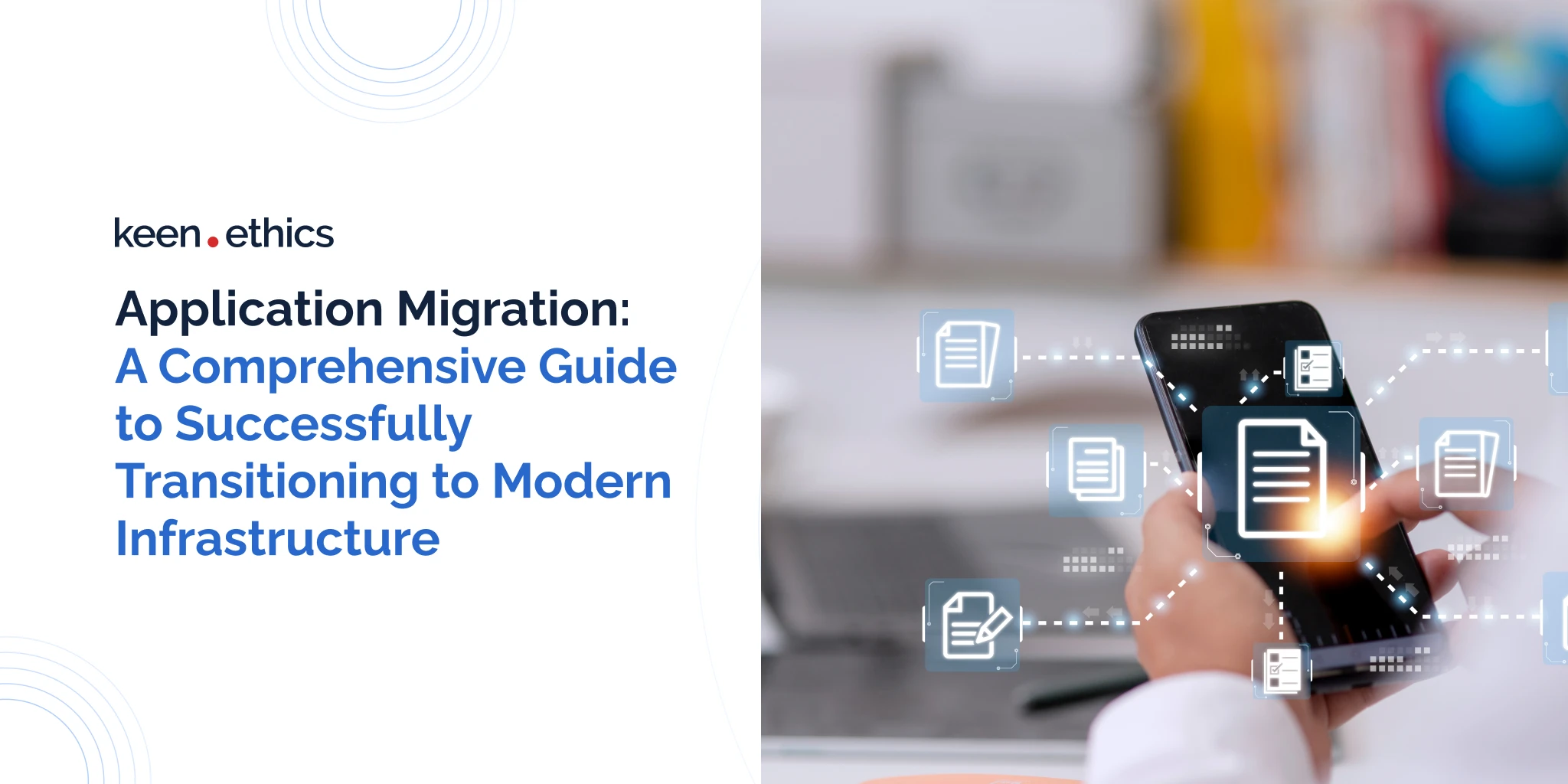App migration is a process that genuinely saves time and money. Learn how to perform it in this article!
I. Introduction
A. Problems with outdated software
Thousands of companies continue using old software and hardware. For example, many hospitals use software compatible only with Windows 7 or even Windows XP. What’s the problem here? These systems are legacy not only from the standpoint of quality but also in a literal sense. They’re so outdated that most desktop users no longer use them.
Occasionally, difficulties with outdated software can get even worse. Unemployment records in the U.S. are much more outdated than most people expect. Many of them use software and hardware from the 1970s and the 1980s. The costs of transitioning to newer systems are so significant that the U.S. government has to hire retirees. Often, only they know how to deal with programming languages such as COBOL.
Why is this so damaging? Firstly, older software and hardware are slow and incompatible with newer platforms. Getting some records in older systems is extremely time-consuming. Secondly, these systems tend to be vulnerable to hacking. Even a small exposure to the Internet may end in a massive loss of information or a data leak. In short, the longer you wait, the worse your security and productivity will become.
B. Importance of migrating apps to modern infrastructure
What should one do to avoid these issues? The key practice is to have a clear process for app migration. App migration is about moving your app from older platforms to newer ones. There are many types of app migration. Sometimes, you’ll have to move to a newer programming language version. In other cases, a full rewrite for newer software may be necessary. This article will offer a detailed guide on this topic. You’ll learn about the following aspects:
- Definition of app migration;
- Reasons to migrate apps;
- Types of app migration;
- App migration strategies and best practices;
- Challenges and risks of app migration;
- App migration to the cloud;
- Real-world successful examples of app migration;
- Future outlook: the role of new technologies in app migration
II. Understanding App Migration
Let’s review the key definitions of application migration. We’ll be able to work with more complex concepts after understanding this technology.
A. Definition and key concepts
Every development environment eventually becomes outdated. And, at some point, using old platforms is no longer rational. This phase is the key trigger for app migration.
So, what is this concept? What does it stand for? App migration is about moving an app from one environment to another. For example, many companies move their apps from Ruby on Rails to C# or JavaScript. Another common request is to transfer data to new databases, such as SQL. Transition to new operating systems is also widespread. According to Tech Radar, various ATM bank security apps are still stuck on Windows XP. In this case, one must adapt them to new operating systems and go from older development platforms to newer ones.
App migration can take diverging forms, including:
- Platform Migration;
- Data Migration;
- Cloud Migration;
- Database Migration;
- Version or Technology Upgrade.
Further in this section, we’ll discuss these aspects in greater depth.
B. Reasons for migrating apps
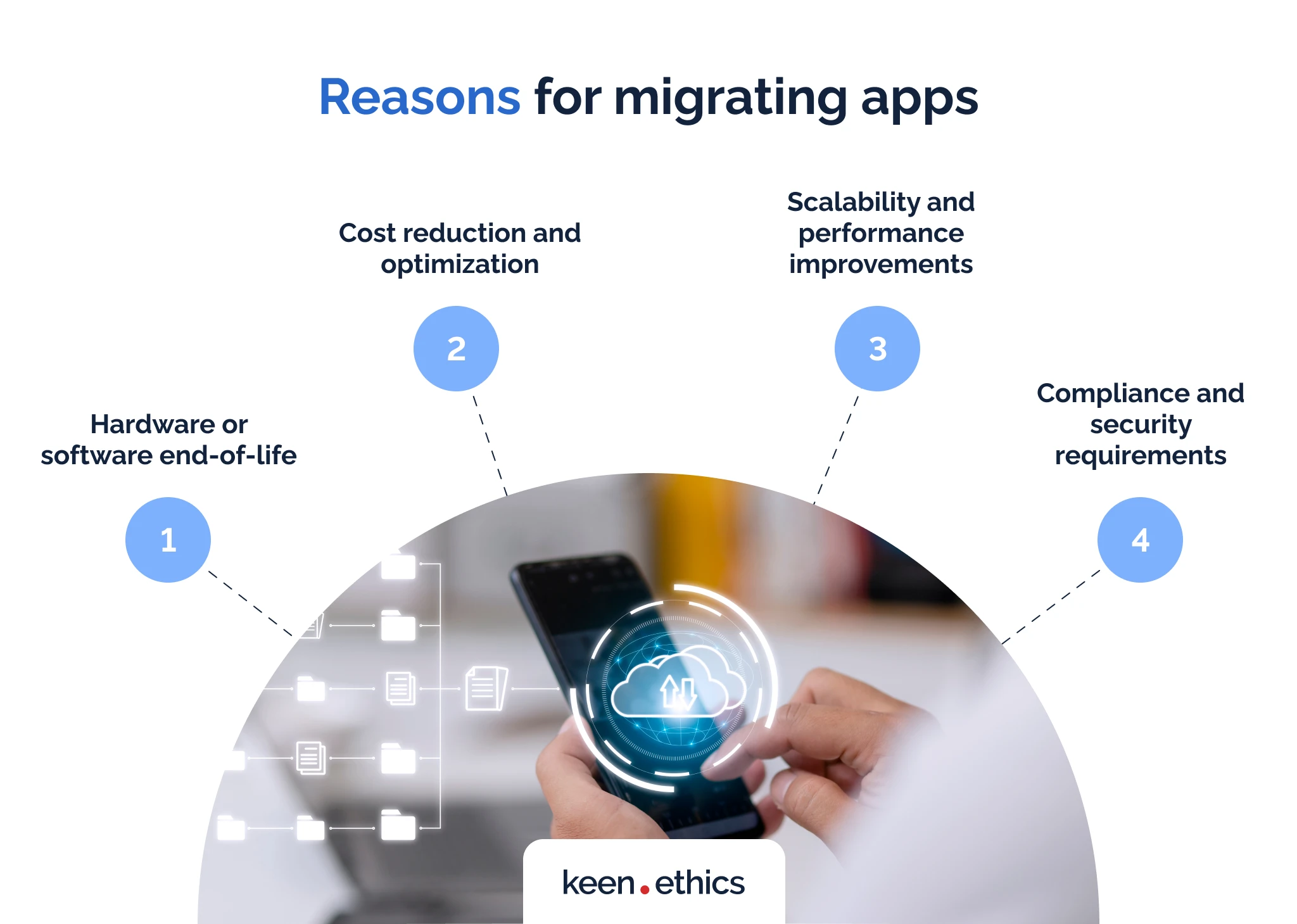
In our opinion, multiple reasons to perform app migration exist. Let’s discuss all of them in depth:
1. Hardware or software end-of-life
Above all, businesses go for app migration due to hardware and software end-of-life.
Software end-of-life is typically less acute. Many programming languages have legacy versions that no longer receive support. In this case, changing everything isn’t imperative. Upgrades involve the deprecated parts, which may become extensive but not all-encompassing. Most programming languages from the 2000s and even the 1990s are still alive. Consequently, the decision to transition towards new languages involves a desire to completely remake some apps. Past languages may limit new features rather than disrupt older ones and security.
As for the hardware end of life, the situation is usually more acute. Today, some organizations are still using old hardware. For instance, many European and American governments work with older computers. Why? A full-scale transition requires a lot of time and money. As a result, various organizations postpone changes. They fear such risks as data loss and delays in service provision.
In this respect, a major problem is that older devices will inevitably fail. Many companies producing parts for them no longer exist. A transition has to happen at some point. Usually, this transition must be as radical as possible. You’ll have to rewrite all past code, as older machines use outdated coding languages such as BASIC. A plan for transitioning older data to newer devices will also be essential. Virtual machines for older hardware and even custom-built transition apps may be crucial.
2. Cost reduction and optimization
Many older technologies are expensive to maintain. Why? You play against two negative tendencies. Firstly, the number of technical experts is decreasing. Few people know the intricacies of Windows XP and related programming languages today. As a result, their services inevitably become pricier. Secondly, older hardware also needs parts that are increasingly difficult to find. In fact, many companies don’t even know how to reproduce past technologies. Various devices that allegedly reproduce older devices (consoles or computers such as Spectrum ZX) use newer hardware combined with emulators. In this light, you start facing increasing costs. An app migration project can reduce them once and for all. Newer hardware and software have more relevant specialists working with it.
Moreover, a recent slowdown in hardware and software development means upgrades from current technologies will be less acute. Many processors from the early 2010s still function well. New technologies allow decreasing an average budget for maintaining your app.
3. Scalability and performance improvements
The progress of hardware and software is tremendous. For example, we see major improvements in processors. The recently announced Intel N100 processor is as powerful as the 2017 Core i5 7400. The latter processor will be viable for many medium-load computing tasks for at least ten more years. What’s the catch? N100 consumes only 6 Watts of energy, instead of 65 in an older processor. A firm that uses newer processors will pay less for electricity than the one on the older hardware.
Similar improvements occur in modern software platforms. With every 2-3 major version releases, Node.js becomes 20% to 50% faster (depending on the task). Where does this information come from? Rafael Gonzaga offers a detailed breakdown of the performance differences between Node.js 16, 18, and 20 in his blog. If you use an older version of Node.js, your site or app will be slower than they can be. Consequently, transitioning to a newer version benefits your business in all cases. Above all, this process will optimize your site or app and make it easier for customers to use. In turn, a more user-friendly experience will lead to better site results. Moreover, you’ll be able to save money on server maintenance.
4. Compliance and security requirements
A major problem of past software is that it uses outdated security protocols. Platforms from the 1980s and 1990s have no good security tools. The majority of our encryption technologies didn’t exist at that time. Many platforms from the 2000s aren’t better. They have greater Internet access, making them even more vulnerable. Windows XP is so “legendary” for being infested with viruses that some artists dedicate art installations to this phenomenon. At the same time, various banks continue to use this operating system in their ATMs.
Newer frameworks and operating systems are less prone to past security issues. For instance, modern Windows versions shield users from Internet threats better than Windows 7 and XP. The in-built antivirus in Windows 11 is genuinely high-quality. If you use older software in this system, it can act as an entry point for hackers.
Lastly, security updates targeting problems like Heartbleed are developed for programming languages and frameworks constantly. For example, Node.js developers continuously develop anti-cross-site scripting solutions. Up-to-date software can protect against many issues.
C. Types of app migration
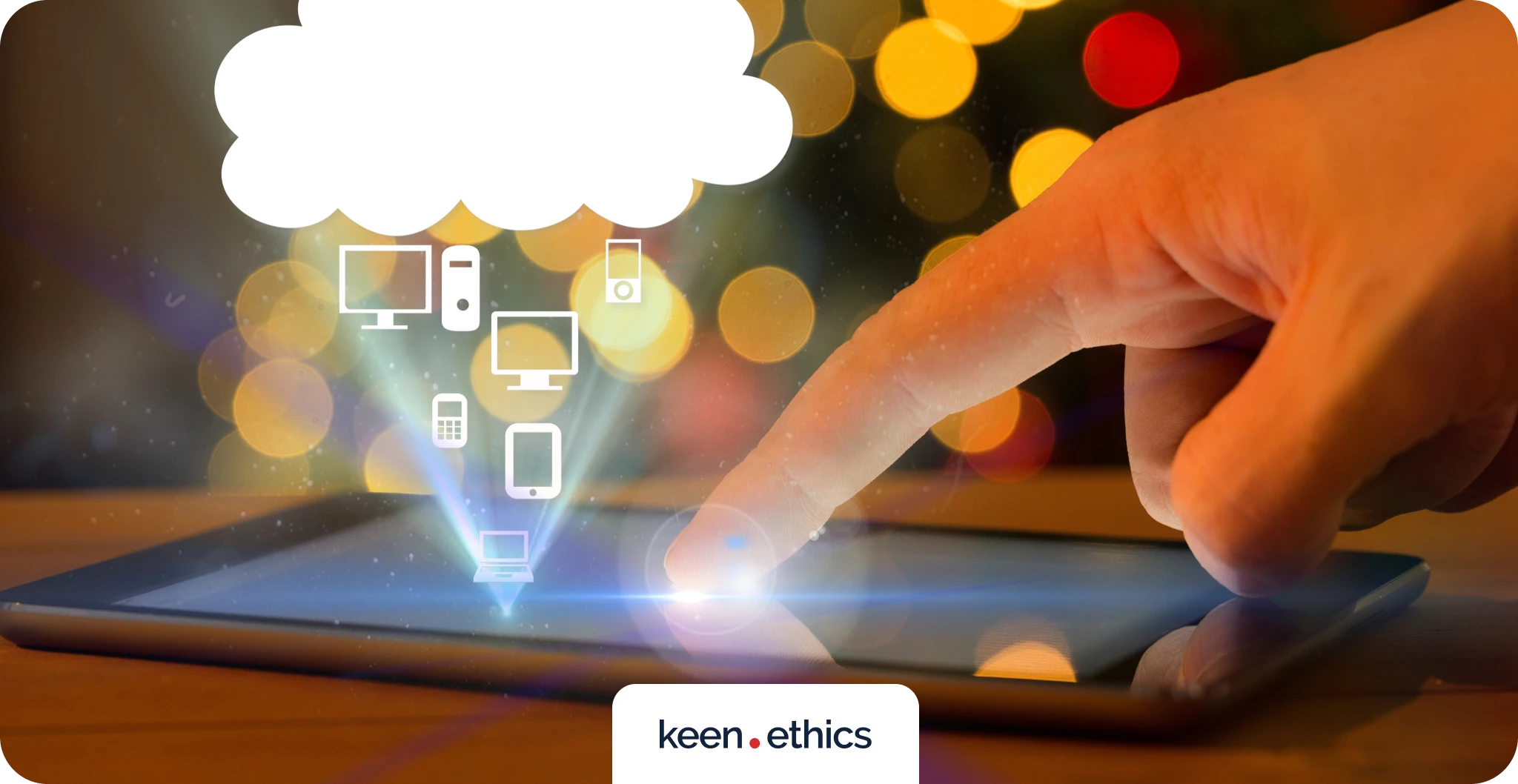
Many types of app migration exist. Different companies require diverging strategy based on their needs:
1. Rehosting (Cloud and database migration)
This type of app migration is typically the easiest to implement. Rehosting is about moving your app and data from one host to another. Does it require some new code? Most likely, yes. You need to identify components that will ease integration into the newer clouds and databases. At the same time, there’s no need for large-scale refactoring in this case. Usually, rehosting is necessary when an older host uses outdated technologies or is about to be closed. In many ways, cloud and database migration is the cheapest service on the market. Other types of app migration are more costly.
2. Replatforming (platform migration)
Platform migration is a much bigger transformation. It involves the modification of an entire platform that is running your app. The most common example of this practice is the transition to a newer operating system. Many enterprise apps tend to use older operating systems. For instance, various hospitals still used Windows XP in 2016 and Windows 7 in 2019. Both systems are deprecated today, receiving no security updates. In this light, whole enterprise networks become vulnerable to hacking. Replatforming can remove this challenge once and for all.
What’s the catch, however? You often have to rewrite a lot of code. Many apps that used to work on Windows 7 and Windows XP no longer work on Windows 10 and 11. The reason is simple: they use newer versions of some frameworks. Node.js 10 won’t be compatible with an operating system using Node.js 20. As a result, re-platforming requires an extensive rewrite of certain apps. It may be necessary to redevelop an app from scratch if it’s old enough.
3. Refactoring (version upgrade)
Refactoring usually occurs in two cases. Firstly, your initial code for an app may be low-quality. It’s a common situation. Many startups become popular due to their concepts rather than execution. Young enthusiasts behind them often don’t have enough experience to create viable code. At some point, it inevitably becomes too limiting for the further evolution of an app. In this case, refactoring involves a rewrite of low-quality parts and framework upgrades. Twitter is a perfect example of this problem. Its starting code required massive rewrites. In fact, Elon Musk believes that the platform now needs a complete rebuild.
Secondly, a common situation is that an app is in great shape but uses old framework versions. In this case, refactoring involves an adaptation to a newer platform. For example, the differences between Python versions 2 and 3 are significant. In this light, committing an entire team to rewriting the incompatible parts is necessary. Why is this so important? Older programming language versions also use older libraries. They may be more vulnerable in an enterprise setting. Another issue is that they can limit your ability to deliver new features. An upgraded tech stack inevitably leads to greater flexibility.
4. Rebuilding (technology upgrade)
Sometimes, technologies become too outdated. A typical example of this issue is COBOL. Yes, new compilation software and extensions are still being developed for it. Nonetheless, the language uses many inefficient design practices. It was great in the 1960s and 1970s, but now we have better solutions.
In such situations, the best choice is to consider a complete app rebuild. What does it involve? The idea is to redevelop your app in a new language. For instance, you can transition from COBOL to C# in your business operations. This process is likely the most costly out of the presented practices. It requires a more or less complete transformation of your app. Still, this practice is usually the most reliable approach for various businesses. The more you postpone a transition to newer software, the greater the business costs.
5. Retiring (combination of multiple migration types)
Lastly, some apps can benefit from retiring. Retiring involves a complete removal of any support for certain apps. When is it useful? In our opinion, it’s great when you already have alternatives for your app. For example, an in-house modeling app may no longer be necessary due to the existence of AutoCAD. In other cases, you may have several new tools that already cover the old functions. Supporting an old app makes no sense in those situations.
In many ways, retiring isn’t a passive process. Many business processes tend to focus on in-house apps. You can’t remove them by one decree. Instead, it’s necessary to engage in active retraining and offer alternatives for your workforce. This process is essential because it can highlight gaps in your transition. For instance, certain original functions may be absent in newer apps. In such a situation, you’ll have to hire developers to create extensions for them. All in all, this process requires active thinking from the managers.
III. Application Migration Strategies and Best Practices

Now that we understand app migration, we must discuss more complex concepts. In this section, we’ll outline the most effective application migration strategy. This process requires several key steps from developers and managers:
A. Assessing the current app landscape
The first step to consider is the analysis of your current situation. In this case, you have two main goals.
1. Identifying apps for migration
Primarily, you need to identify apps you want to transform. Every business likely has several candidates for large-scale migration. Try to find as many elements as possible. For instance, a publishing business may need transformations in accounting and editing apps.
How should you perform this analysis? Create an inventory of all key apps in your company. Then, look at their production years and collect usability data. If users are no longer satisfied with an app, and it has major security errors, it’s time to transform it. In our opinion, a strong test here is the ability of an app to work in modern operating systems. If it can’t do this, it’s time for major changes.
2. Prioritizing apps based on business impact and complexity
As we’ve mentioned, a common situation is that multiple apps need modifications. Obviously, upgrading all software simultaneously is an unrealistic step. What should you do at this stage? The key step here is to understand your priorities. A book publishing business, for example, relies on its editing tools more than on accounting ones. In this situation, rebuilding or refactoring your editing app is the most rational choice. Generally, you should look at your business requirements. Remove the most inefficient apps at first. You must clearly understand your answer to one simple question: “Why transition?”
B. Developing a comprehensive migration plan
Once you’ve chosen apps that need changes, it’s time to start planning the transition itself. A comprehensive migration plan is what you need:
1. Defining migration goals and objectives
Your primary step is to outline the key goals and objectives of your migration. If we continue with our publishing house example, here are some key steps it may need:
- Choosing a proper framework for a new app;
- Establishing strategies for recreating past functions;
- Developing an app itself;
- Establishing fall-back strategies;
- Ensuring long-term development for an app.
2. Establishing timelines and milestones
A vital step is to have clear timelines for all your actions and milestones for them. You should be able to answer two questions: when and what? Firstly, you must know when certain features will be completed. This approach allows us to comfortably manage downtime through tools like VMware.
Secondly, you need to know what constitutes success. If you define categories too broadly, confusion is inevitable. Some stages may seem fast, creating an illusion of tremendous success. Others may take too much time, disrupting optimism. In our opinion, the best option is to have various small-scale goals. They will help you better understand everyday progress. Following such a plan and reporting it to superiors is easy. More importantly, assessing your capabilities through it is easier, too. Smaller goals are more detailed and enable a more thorough time analysis.
3. Allocating resources and budget
Once you understand all these steps, it’s time to allocate resources and budget for development. That’s the reason why we recommend detailing your plan. When you understand all the small tasks within it, allocating resources is easier. Here, using resource allocation tools such as PERT and the Critical Path Method is a great idea. If you’re eager to learn more about these methods, don’t hesitate to read our article on this topic. Modern calculation methods accurately predict how much certain projects cost. You can contact us if you would like an expert assessment of project costs. Our company has over eight years of experience developing projects for fintech, healthtech, and edtech.
C. Preparing the target infrastructure
A large aspect of success is having the right infrastructure. Upgrades make no sense if you have only Windows-XP-capable computers on-premises.
1. Ensuring compatibility and interoperability
Above all, ensure you have appropriate hardware. Transition planning always requires an analysis of your hardware. Many companies use outdated computers. You’ll need newer hardware if you want to transition to newer software.
Another aspect of a strong software migration plan is interoperability. You should ensure your new or updated app can work with older hardware. According to Universe Today, a space-related news website, various space technologies continue to use rather ancient processors. This phenomenon is also widespread in the healthcare and manufacturing industries. In numerous instances, older software may use slow computers because they’re extremely reliable. Your coders should consider this factor and have high-quality compatibility layers.
One more reason to support interoperability is business cooperation. Many companies may be lagging behind your upgrade plan. In this light, you should be able to produce output they’ll be able to use. Virtual machines may be the optimal case for some outdated formats. In other situations, you should consider converting software for various data formats.
2. Implementing necessary security and compliance measures
One of the key reasons to implement newer software is security. Consequently, you should create a clear plan for computing safety. In the case of app migration, many things may require active testing and maintenance. You should review the state of new code, compatibility layers, and even virtual machines.
Another important aspect includes compliance. Older software is often used due to its reliability in high-stress environments. Space shuttles use older hardware and older apps. Our modern 100-dollar smartphones are more powerful than this hardware and use faster programming languages for software. Nevertheless, many organizations continue to use it due to reliability. You should actively plan how your app will fit into the key third-party standards for industrial fields. Your software shouldn’t be just new. It should also be extremely reliable. This search for better security standards is undoubtedly one of the most difficult processes in modern development.
D. Executing the migration
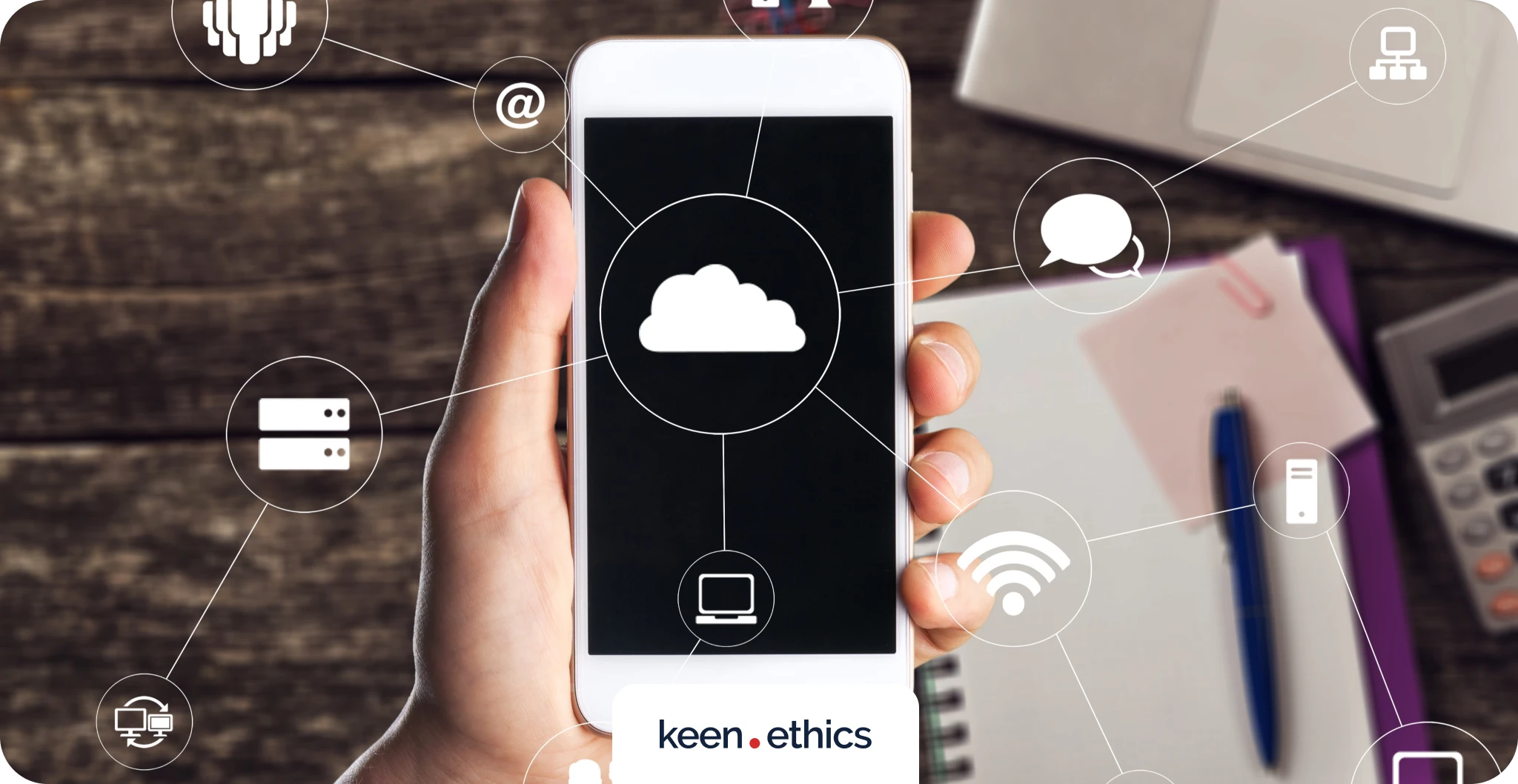
After all the planning is over, it’s time to execute the migration itself. What should your steps be here? Here are the key aspects:
1. Data migration and transformation
All past software and hardware feature a lot of data. For example, a publishing business may have various formatting settings in past apps. You need to consider the process of moving them properly. Transferring accounting data to the cloud is a complex task. You’ll need to deliver custom tools for automatic conversion and probably have a quality control team for reviewing data transition. This task is so difficult that separate custom converter development companies exist. Our company also has major experience with such conversion. Consequently, you can address us to create software for high-quality data transformation.
2. Application code development and configuration adjustments
When you have a full process for transferring data, it’s time to develop new code. Here, the best option is to use tried-and-tested frameworks like Waterfall and Agile. They all have unique benefits. Some are better for stable projects. Others are great when you need unique configuration adjustments. For instance, the aforementioned frameworks have the following positives:
- Waterfall:
- Clear project scope and requirements upfront;
- Sequential and linear approach;
- Well-suited for projects with stable and well-defined goals.
- Agile:
- Flexibility to adapt to changing requirements;
- Incremental and iterative development;
- Emphasis on collaboration and customer feedback.
3. Testing and validation
The final step before releasing a full app is to actively test it. Often, a transition from older software to newer one is necessary for firms using specific hardware. In this light, any error in new software can end in long-term financial losses. What should you do at this stage? Hire a team of quality assessment specialists. They will test your new software in all possible situations. Using this approach, you can remove errors before they become acute. TechRepublic notes that software failure caused 1.7 billion dollars of financial losses in 2017. This figure is likely growing. Testing is the key path to avoiding this problem in your company.
E. Post-migration activities
Once development and testing are over, you should continue interacting with your software. What are some steps to consider? Here they’re:
1. Monitoring, performance optimization, and new features
One of the key reasons to use new or updated software is to speed up your apps. In this respect, you should capitalize on this aspect. Monitor their performance and optimize it further. When your coders gain more experience using a newer system, they’ll find some paths to make it more optimal. Some of your users may also be able to discover critical problems in the software. In short, development never ends with newer apps. You need to constantly review them and assess your processes.
Another important practice to consider is the creation of new features. Yes, we usually refactor code to make it faster or more secure. However, newer code may also make development easier. For example, modern tools are more compatible with newer AI frameworks. Integrating them into new code should be generally easier. This feature allows changing your approach to dealing with some tasks. For instance, you can use machine learning to assess parameters in your alloy production. With this information, adjusting it and making the process more efficient will be easier. In short, new code also opens a path for tools such as ChatGPT or predictive analytics.
2. Decommissioning legacy systems
When you transition to a newer system, older frameworks must stay in place for some time. Why? Firstly, newer systems may require training to function well. Secondly, removing older features until you test your new software for vulnerabilities is dangerous.
We recommend decommissioning older systems in stages. Start with less critical functions and gradually transition to the more important ones. You can remove old software altogether once you have fail-safe approaches for all incidents. The worst thing to do here is hurrying. It’s better to maintain an outdated system for your machines for several years than to run into some compatibility or stability accidents. Always prioritize stability over convenience.
3. Training and knowledge transfer
New systems will also inevitably have newer approaches to managing common user tasks. For example, many earlier Oracle planning products had keyboard-oriented interfaces. Newer ones use a keyboard and mouse style. In this light, you’ll have to retrain some employees to use the new style. Obviously, certain features will work differently, too. As a result, you should ask your app provider to clearly outline all the changes before abandoning the old software.
IV. Challenges and Risks in Application Migration
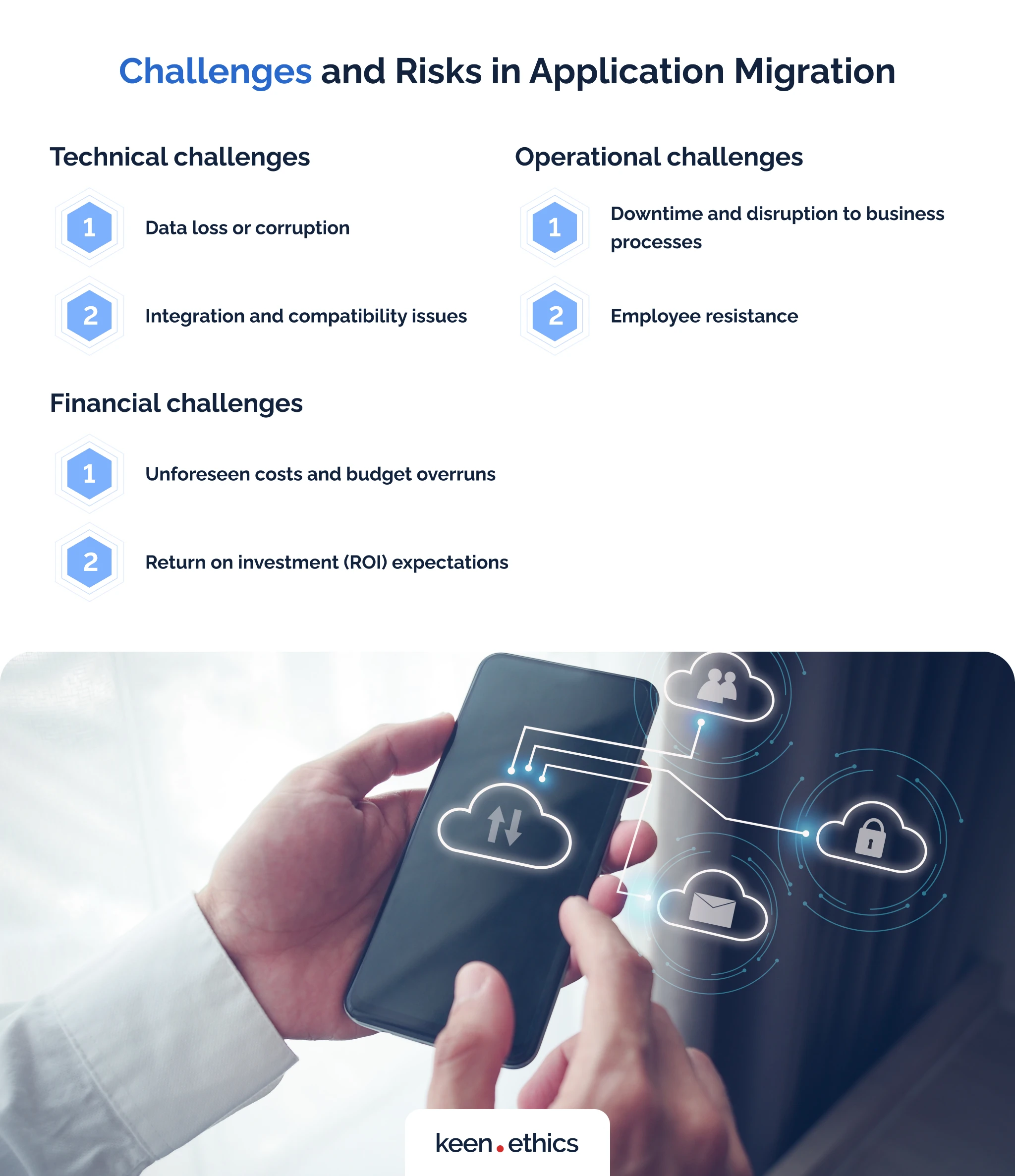
While app migration brings major value, it’s also a major risk source for various companies. For this reason, every software migration plan must also involve the analysis of the key threats:
A. Technical challenges
Above all, various companies can encounter major technical challenges. Here are the key ones:
1. Data loss or corruption
This issue usually comes in three forms:
- It may occur between different versions of one software. Small changes in them can make some files unreadable in newer versions of your custom apps. Regrettably, contact with a newer version of an app may corrupt the older files, making their restoration difficult.
- Transitioning from one system to another is also a major problem. Old data formats from the 1980s are challenging to implement in modern systems. An incorrect interaction with old databases can easily disrupt them.
- The data transition from the dedicated servers to the cloud may also result in data loss or corruption. Low-quality Internet connection is often a key culprit in such incidents.
Thankfully, avoiding these concerns is simple. All you have to do is prepare backups via a 3-2-1 method and create custom conversion tools.
2. Integration and compatibility issues
This challenge occurs when you transition between different software versions or different software. A perfect representation of this issue is the compatibility of older Excel (2003, for instance) versions with newer ones (2021). Complex macros from the older versions often fail on the newer ones. While corruption is unlikely, this problem will nonetheless make the transition difficult. A complete rewrite of the old macros will be necessary in many cases. In short, data loss and integration difficulties aren’t unbeatable. What they will require, however, is a major investment into innovations.
B. Operational challenges
All app migration processes also include major operational challenges. Here are the key problems you’re likely to encounter:
1. Downtime and disruption to business processes
Any transition to the new systems will inevitably disrupt your business processes. Above all, you’ll have downtime due to the deprecation of the old systems. More importantly, new processes will likely require learning. When you migrate application data or even whole apps, be ready for a slowdown at first. Your employees will have to learn how to use new systems. Yes, the main benefits will come later. But you’ll have to wait for them.
2. Employee resistance
Many employees are afraid of new technologies. Why? They fear that these innovations will displace them. The fear of losing a job is especially significant for older workers. For this reason, these individuals may start presenting new systems as utterly inefficient. In the most extreme cases, direct sabotage is also possible. HBR reports that neo-Luddite ideas are becoming popular in the world. For example, various individuals are utterly afraid of AI.
What should you do at this stage? Firstly, show how this technology will benefit everyone. Secondly, prove that new technologies won’t take away old jobs or that you’ll train your employees for a newer position. Showcasing job security is essential in this situation.
C. Financial challenges
Ultimately, an application migration plan may also result in large-scale financial losses.
1. Unforeseen costs and budget overruns
The first reason why those losses may occur includes unforeseen costs. Usually, when you develop a new app, budget overruns are less likely. Why? These apps typically include well-tested technologies that won’t lead to any major surprises. However, you have to interact with older tech stacks in case of app migration. In this situation, the probability of something unexpected happening is large. You have to be ready for data conversion or code repurposing expenses. Virtualization solutions often require more funds than expected, too.
2. Return on investment (ROI) expectations
Predicting the return on investment from app migration is difficult, too. Occasionally, the benefits of a transition may become obvious in three or even five years. Not all operations require speed and security. Many industrial objects, such as foundries, can easily work with older hardware and software. In practice, you should always view app migration as a long-term investment.
V. Application Migration to the Cloud

The most widespread path for app migration involves clouds. Let’s review the key aspects of software migration planning for this field:
A. Benefits of cloud migration
In our opinion, cloud migration brings three key benefits for the average user.
- Firstly, it leads to cost savings and improved operational efficiency. As you’ll see in a Netflix case below, cloud technologies allow clients to handle more connections at a lower cost. Clouds are perfect if you need to perform complex calculations or scale an app for various users.
- Secondly, you receive more flexibility for your projects. For example, Migrate, a Brazilian company dealing with tax documents, managed to deliver more tax management features for its customers through Google Cloud integration.
- Lastly, cloud services are typically more secure than dedicated servers. In this case, you get access to collective security managed by large-scale providers. For instance, Google and Amazon offer high-quality anti-DDoS services.
B. Cloud migration strategies
When developing your application migration checklist, you should consider three types of cloud app migration. Here they’re:
- Infrastructure as a Service (IaaS): IaaS provides virtualized computing infrastructure over the Internet. Users can rent virtual machines and networking resources on a pay-as-you-go basis. Amazon Web Services (AWS) Elastic Compute Cloud (EC2) allows users to rent virtual servers in the cloud. They can control operating systems and software but not the underlying hardware.
- Platform as a Service (PaaS): it’s a cloud computing service that lets customers manage apps without having to worry about infrastructure. Heroku is a strong example of a PaaS provider. Developers can deploy their apps without managing servers or underlying infrastructure.
- Software as a Service (SaaS): SaaS delivers apps over the Internet. It eliminates the need for users to install, maintain, and update software. Users can access it through a web browser. Google Workspace is a great example of SaaS. It includes apps like Gmail, Google Docs, Sheets, and Slides. They’re all accessible via the Internet. Most likely, all our readers are familiar with these solutions because they’re extremely popular today. Google even centers a whole operating system, Chrome OS, on SaaS.
C. Choosing the right cloud provider
The final step to consider is choosing the appropriate cloud provider. In this regard, you have to focus on two key steps:
- Comparing features and capabilities: providers have different value propositions. Some deliver large storage at a lower price but are worse at processing speed. Others concentrate on better security features. You should review as many options as possible before making the final choice. Occasionally, it makes sense to pay more but to get a better service;
- Assessing service-level agreements (SLAs) and support: a potent cloud service isn’t only about storage size or speed. It should also have strong service-level agreements. Some companies are extremely aggressive and push suboptimal conditions for their clients. You should cooperate with your legal team to ensure the highest level of safety. Besides, it makes sense to look at support capabilities. Some businesses offer great speed but won’t solve your problems in case of major internal issues.
VI. Real-World Examples of Successful App Migration
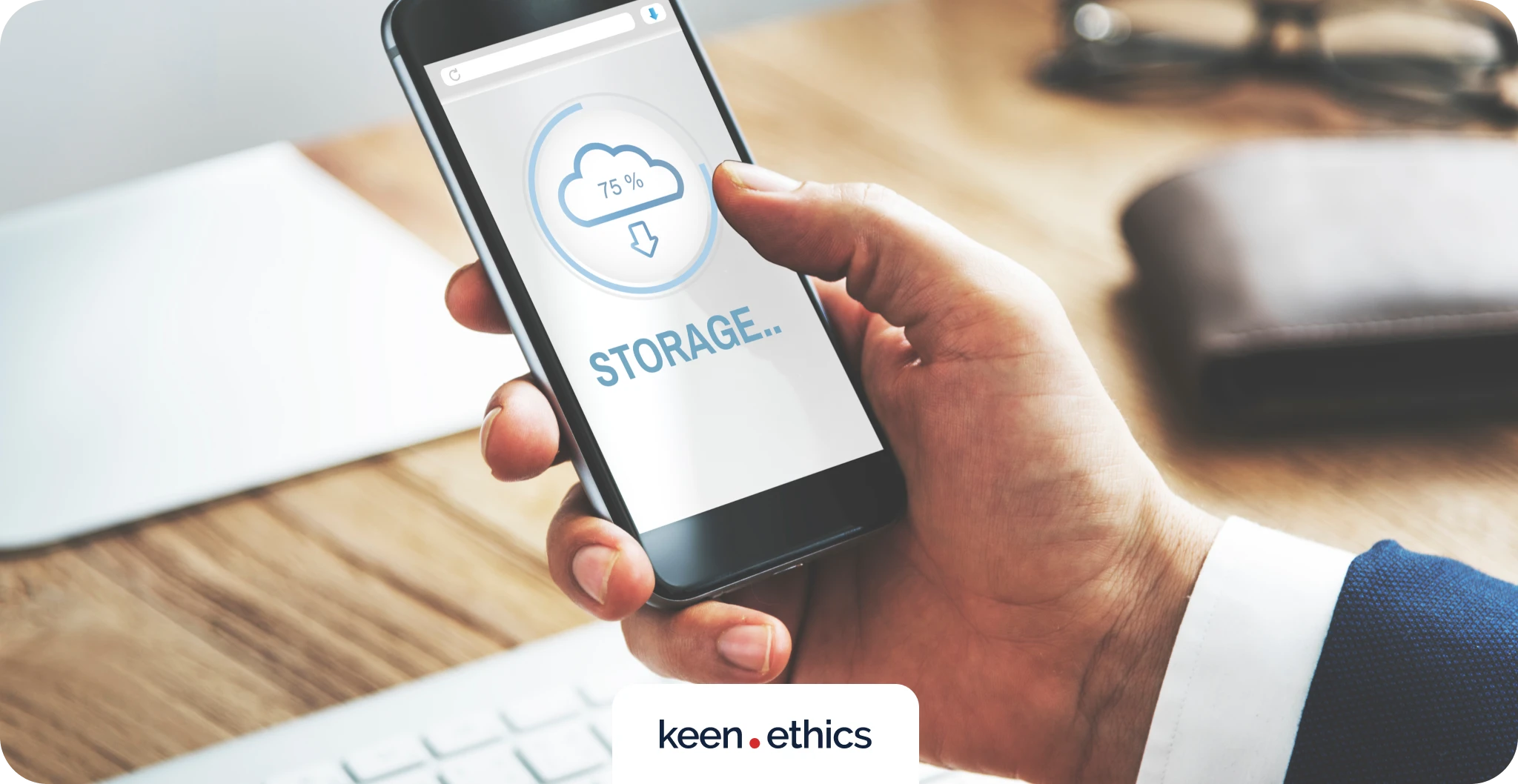
A. Case studies showcasing successful app migration projects
Let’s review case studies showcasing successful app migration projects. As you can see, they’re numerous:
Netflix
- Challenge: Netflix initially operated on physical data centers. Eventually, it faced scalability issues as its user base grew globally.
- Solution: Netflix migrated its infrastructure to Amazon Web Services (AWS). This approach allowed the business to leverage the cloud’s scalability and flexibility. They adopted a microservices architecture and implemented homegrown tools like Chaos Monkey. The key goal here was to defend the internal systems against random events.
- Result: This migration allowed Netflix to handle its massive user base. More importantly, the company can now implement new features and better video quality. The move to the cloud was pivotal in Netflix’s success as a streaming giant.
Spotify
- Challenge: Spotify had a monolithic architecture based on a traditional server approach. It hindered the rapid development and deployment of new features.
- Solution: Spotify adopted a microservices approach and containerization using Docker. They also migrated to the Google Cloud Platform (GCP) for improved scalability.
- Result: The migration allowed Spotify to develop and release features more quickly. It can now scale its infrastructure according to demand.
Capital One
- Challenge: Capital One, a financial services company, aimed to transition from traditional data centers to the cloud to enhance agility and reduce costs.
- Solution: Capital One embraced AWS for its cloud migration. They focused on moving apps to the cloud and refactoring them for the web.
- Positive Results: Capital One successfully migrated critical apps to the cloud. This approach allowed the company to deliver new features faster and more easily.
- Negative Results: simultaneously, the transition to the Interest made the firm more vulnerable. In 2019, a hacker managed to steal 100 million credit applications from Capital One. Dark Reading, a cybersecurity-centric website, reports that this outcome became possible due to a misconfigured AWS server. Some data wasn’t protected by passwords. As a result, a data leak happened.
B. Lessons learned from these examples
Ultimately, the presented information showcases several lessons regarding app migration:
- It leads to massive improvements in your ability to deliver new features;
- It enables one to scale their service for a large audience;
- App migration saves costs because it promotes newer and faster software;
- Transition into the cloud is associated with security risks. You should hire more experts who know how to deal with cybersecurity.
VII. Future Outlook: The Role of Emerging Technologies in Application Migration

We hope that application migration steps are clear to you now. Let’s look at the emerging technologies that can greatly ease migration:
A. The impact of containerization and microservices
Containerization and microservices are vital in modern software development. Let’s start with defining these technologies. Containers encapsulate apps and their dependencies. In this way, they ensure consistent deployment across diverse environments.
A perfect example of this technology is Snap for Linux. Canonical devised this idea to make apps work on all Linux distributions. This approach is great for combatting fragmentation that occurs in the Linux community. Snaps run on almost all Linux-compatible operating systems because they create system-independent project packages. You can use this benefit for many other operating systems. For example, a container may help run an app across mobile and desktop platforms without additional redevelopment efforts. All code will run in a container rather than on some device directly.
And what about microservices? They break down apps into independent, scalable components, fostering agility and responsiveness. Traditional apps are akin to big, all-in-one programs. Now, picture microservices as individual apps on your smartphone. Each app (microservice) does one thing well. Then, these subapps cooperate to do complex tasks. If you need to update one feature, you only update one segment and not the whole app. In our opinion, this approach is essential for preventing app aging. There’s no need to engage in large redevelopment if you have several microservices. You can update some elements gradually, preventing overload.
B. The role of automation and artificial intelligence (AI) in migration processes
Another technology that will play a major role in app migration is AI. In this regard, we see two potential uses for this technology. Firstly, AI can produce code for different app migration goals. Since it contains a lot of human knowledge, a generative system can easily come up with solutions for old frameworks. Secondly, we believe algorithmic AI will soon be able to give high-quality recommendations on app migration. For instance, it’ll be able to analyze if the transition process made sense financially. Using these automation tools, you can develop transfer solutions for your past instruments faster.
VIII. Conclusion
App migration that’s managed well can reinvigorate your business. Old software and hardware create tremendous limits. They tend to be slow, and their security is usually low. In this light, it makes sense to completely remake your existing systems or upgrade them to newer platform versions. We hope this article has offered you a detailed guide on how to do this.
Ultimately, app migration requires careful planning and almost perfect execution to bring fast benefits. Otherwise, this practice will remain a long-term investment. Addressing specialists is the best choice if you want to do a cost-efficient app migration. In this respect, our company, Keenethics, may be a strong partner for app migration. We have eight years of experience developing projects in the fintech, healthtech, and edtech fields.
Keenethics can become your next proactive app migration partner.

